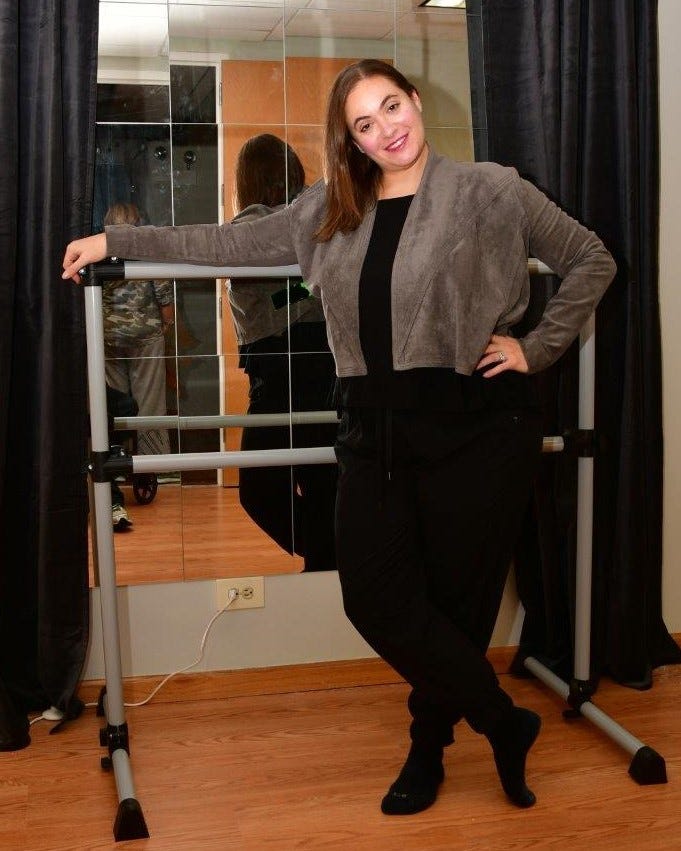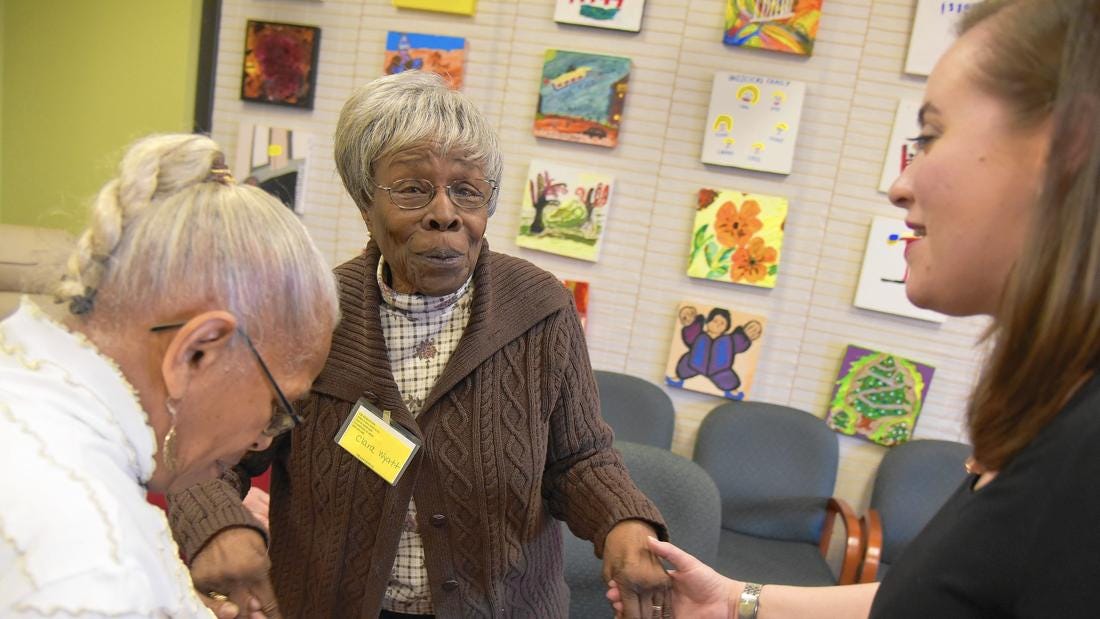Taking the time to walk at the pace of my thoughts, matching the intensity of the “rushed” feeling and then gradually slowing the pace allows for me to slow down my body which slows down my need to rush as well as the thoughts in my head that may be swirling around.
Our body stores everything, good and bad. If we can practice being more mindful of our bodily sensations, aches and pains, even where we are in space and our spatial awareness, we can easily become more mindful people.
As a part of my series about “How to Slow Down To Do More” I had the pleasure to interview Erica Hornthal. Erika is a licensed clinical professional counselor and board-certified dance/movement therapist. Erica is the founder and CEO of Chicago Dance Therapy, a group practice founded in 2011. As an expert on the intersection of movement and mental health, Erica has appeared in publications, podcasts, live news, and radio including WGN, NBC, The Chicago Sun Times, The Chicago Tribune, Buzzfeed, Bustle, NBC News Better, Reader’s Digest, Prevention and as a columnist for Dance Informa Magazine, 30 Seconds, and Thrive Global. It is Erica’s mix of talk therapy and body-centered psychotherapy that earned her the nickname “The Therapist That Moves You.” In addition to seeing clients Erica is a passionate seasoned public speaker with more than 10 years experience in presenting talks and workshops at Fortune 500 companies, business organizations, women’s groups, professional associations and universities. Erica resides in Chicago’s North Shore with her husband, daughter, and 2 French Bulldogs. When she is not seeing clients, Erica can be found spending time with family, dancing as often as possible and working on her first book.
Thank you so much for joining us! Can you tell us the “backstory” about what brought you to this specific career path?
I like to say that dance therapy chose me. I always enjoyed dancing as a kid. My mom told me that I was always dancing and so at the age of 4 she decided to put me into a dance class. That is where my passion for dance began and although I strayed for a few years to pursue other sports (swimming, tennis, gymnastics), I always came back to my first love. So, naturally as a young adult trying to figure out what I wanted to do with my life I assumed it would involve dance, but my passion for dance and love of science seemed completely unrelated until I was introduced to the field of dance/movement therapy. Dance/movement therapy has allowed me to take my passion and innate ability to express myself through dance and movement and marry it with my love for psychology and mental health. I am now able to use movement to help my clients reach their full potential.
According to a 2006 Pew Research Report report, 26% of women and 21% of men feel that they are “always rushed”. Has it always been this way? Can you give a few reasons regarding what you think causes this prevalent feeling of being rushed?
I believe this is causes for several reasons.
- We allow others’ expectations and deadlines to control our pace.
- We have difficulty shutting down.
- Taking our time to do something feels inefficient so we do it as quickly as possible.
Our society is built on instant gratification and getting things the minute we think about it. So, naturally we hurry ourselves to do what we have been conditioned to think is necessary.
Based on your experience or research can you explain why being rushed can harm our productivity, health, and happiness?
Always feeling rushed can create a state of hyperarousal better known as the “flight or fight” response. That dramatically impacts our mental and physical health. We can feel anxious, nervous, sweaty, agitated, scared, and drained or fatigued. It may feel productive in the moment because it forces you to do what needs to be done essentially for survival, but it does not create a healthy sustainable relationship with regard to work or responsibilities.
On the flip side, can you give examples of how we can do more, and how our lives would improve if we could slow down?
We can increase our satisfaction by being in the moment and present to the task at hand. Slowing down does not mean being inefficient. It can mean being more intentional, focused, and aware of the task at hand whether that is playing with our kids or closing a huge account.

We all live in a world with many deadlines and incessant demands for our time and attention. That inevitably makes us feel rushed. Can you share with our readers 6 strategies that you use to “slow down to do more”? Can you please give a story or example for each?
- Pay attention to when I feel rushed
If we always feel rushed this can become the “norm”. It is important to identify what circumstances perpetuate this feeling. When does it feel most prevalent? Consequently, when do you feel rushed, but actually want to relax?
Give myself permission to slow down
When I feel rushed, particularly if someone else’s expectations or timeline is not in line with my timing I find that giving myself permission to slow down actually helps me focus and accomplish what I need to do.
Breathe
This is involuntary, but concentrating on your breath not even changing anything about it, but just noticing it actually creates the space for us to slow down. Practicing certain breathing techniques can slow down our heart rate and breathing which allows us to rest more easily.
Make lists
Often I feel rushed to get things done before I forget that I even need to do them. Writing them down allows me space to do what needs to be done and not waste the mental space keeping track of the actually to-do list.
Move to improve
Taking the time to walk at the pace of my thoughts, matching the intensity of the “rushed” feeling and then gradually slowing the pace allows for me to slow down my body which slows down my need to rush as well as the thoughts in my head that may be swirling around.
Make myself a priority
I found I was rushing around for others and neglecting myself. Or rushing my own self-care to again assuage others needs or demands. Taking time for me makes me a priority which actually allows me to connect to the things I get done and feel accomplished.
How do you define “mindfulness”? Can you give an example or story?
Mindfulness is bringing awareness to the present moment; how you feel emotionally and physically. It is not just a mental practice. I have found that taking “body breaks” throughout my day has significantly reduced my need to rush. I mindfully check-in with each part of my body. It reduced tension build-up and allows me to slow down.
Can you give examples of how people can integrate mindfulness into their everyday lives?
We can pay attention to our bodies. Our body stores everything, good and bad. If we can practice being more mindful of our bodily sensations, aches and pains, even where we are in space and our spatial awareness, we can easily become more mindful people.
- Practice a body scan
- Take time to breathe
- Walk with purpose, paying attention to the space around you.
- Make eye contact with people as you walk past them.
- Take a different route to work and pay attention to what looks different.

Do you have any mindfulness tools that you find most helpful at work?
I practice the following in my career as well as my personal life.
1) Incorporate the 5 senses to encourage presence
2) Doodling to move anxious energy out of my body
3) Stretching to release built-up tension which allows me to focus and be more productive
What are your favorite books, podcasts, or resources that inspire you to use mindfulness tools or practices.
Bodyfulness by Christine Caldwell takes mindfulness to a whole other level. We need to be mindful in our bodies just as much if not more than our minds.
Can you please give us your favorite “Life Lesson Quote”? Can you share how that was relevant to you in your life?
“Life isn’t about waiting for the storm to pass, it is about learning to dance in the rain.”- Vivian Greene
We often feel like we have to wait for the “perfect” opportunity, job, or circumstance. We could be waiting around forever meanwhile life is passing us by. It is about learning to be in the moment and “dance” in the storm rather than waiting for the sun to reappear. If you can be okay with not being okay or even become comfortable in feeling discomfort, you will appreciate the sunny days even more.
You are a person of great influence. If you could inspire a movement that would bring the most amount of good to the most amount of people, what would that be? You never know what your idea can trigger. 🙂
My “movement” would be to bring awareness to how we move throughout our lives. My philosophy is “you are how you move”. Essentially we need to pay attention to our body language and how our bodies impact our emotional health, our behaviors, our relationships, as well as our personalities which influence our interactions.
Thank you so much for these insights! This was so inspiring!
About the Author:
After 15 years working in Commercial Real Estate in New York City, Ashley Graber changed the coast she lived on and the direction of her life from Real Estate to the worlds of Psychology and Meditation & Mindfulness. Ashley came to these practices after getting sober and in the decade plus since, she now runs a busy mindfulness based psychotherapy practice in Santa Monica, CA where she see adults and young children. Ashley unique combination of psychotherapy, trauma reprocessing and meditation and mindfulness practices makes her a sought after educator and speaker. She educates teachers and administrators in schools and presents in businesses on the benefits of meditation and mindfulness practices
Ashley is also an Owner and Director of Curriculum for the next generation meditation app & mindfulness company ‘Evenflow’ and launched the company’s one to one online mindfulness mentoring program.
Ashley was trained in Meditation and Mindfulness practices by prominent teachers; Elisha Goldstein, Richard Burr and Guiding teacher at Against the Stream Boston, Chris Crotty. Her Mindfulness Based Stress Reduction (MBSR) certification was done through The Center for Mindfulness at UC San Diego. Additionally, Ashley is trained by Mindful Schools to teach Meditation and Mindfulness practices to children and families. Ashley’s passion for the benefits of mindfulness practices as well as her enthusiasm for helping young kids and adults is the drive to teach these very necessary, life long skills and why she wrote and runs the Mindfulness for Families program at The Center for Mindful Living. This is where she teaches groups of families with children ages 6–12.
Ashley was featured on Good Morning LaLa Land, presented on Resilience at the renowned Wisdom. 2.0 Mindfulness & Technology conference, and presented at the TED Woman conference offering an in-depth look at the profound psychological and physiological consequences of chronic stress, and how meditation and mindfulness practices can alleviate these effects. Ashley is also a syndicated columnist for Thrive Global and Medium Magazines.
If you’d like to book Ashley for an inspiring speaking engagement, please click here.


